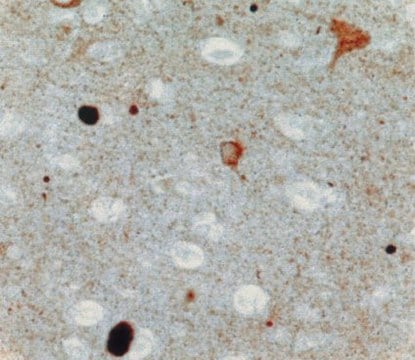MAB1622
Anti-Spectrin alpha chain (nonerythroid) Antibody, clone AA6
clone AA6, Chemicon®, from mouse
Synonym(s):
(ALPHA)II-SPECTRIN, Alpha-II spectrin, Fodrin alpha chain, Spectrin, non-erythroid alpha chain, non-erythrocytic spectrin alpha, spectrin, alpha, non-erythrocytic 1 (alpha-fodrin), Fodrin α
About This Item
Recommended Products
biological source
mouse
Quality Level
antibody form
purified immunoglobulin
antibody product type
primary antibodies
clone
AA6, monoclonal
species reactivity
pig, guinea pig, rabbit, mouse, chicken, rat, human
species reactivity (predicted by homology)
mammals
manufacturer/tradename
Chemicon®
technique(s)
ChIP: suitable
immunohistochemistry: suitable
immunoprecipitation (IP): suitable
western blot: suitable
isotype
IgG1
suitability
not suitable for immunohistochemistry (Paraffin)
NCBI accession no.
UniProt accession no.
shipped in
wet ice
target post-translational modification
unmodified
Gene Information
human ... SPTAN1(6709)
General description
Specificity
Immunogen
Application
A 1:200-1:400 dilution of a previous lot was used in immunohistochemistry.
Does not work on paraffin sections.
Optimal working dilutions must be determined by end user.
Chromatin Immunopreciptiation:
A previous lot of this antibody was used to immunoprecipitate Spectrin Alpha from chromatin-associated protein extracts derived from normal human, HeLa, FA-A, and transduced FA-A cells (McMahon, L.W., et al. (1999). J. Biological Chem. 274:32904-32908).
Cell Structure
Cytoskeleton
Quality
Western Blot Analysis:
1:500 dilution of this antibody detected N-, C- terminal Spectrin alpha/Fodrin alpha on 10 μg of staurosporine treated HeLa lysates.
Target description
Physical form
Storage and Stability
Analysis Note
HeLa cells treated with staurosporine
Other Notes
Legal Information
Disclaimer
Not finding the right product?
Try our Product Selector Tool.
recommended
Storage Class Code
12 - Non Combustible Liquids
WGK
WGK 2
Flash Point(F)
Not applicable
Flash Point(C)
Not applicable
Certificates of Analysis (COA)
Search for Certificates of Analysis (COA) by entering the products Lot/Batch Number. Lot and Batch Numbers can be found on a product’s label following the words ‘Lot’ or ‘Batch’.
Already Own This Product?
Find documentation for the products that you have recently purchased in the Document Library.
Our team of scientists has experience in all areas of research including Life Science, Material Science, Chemical Synthesis, Chromatography, Analytical and many others.
Contact Technical Service








